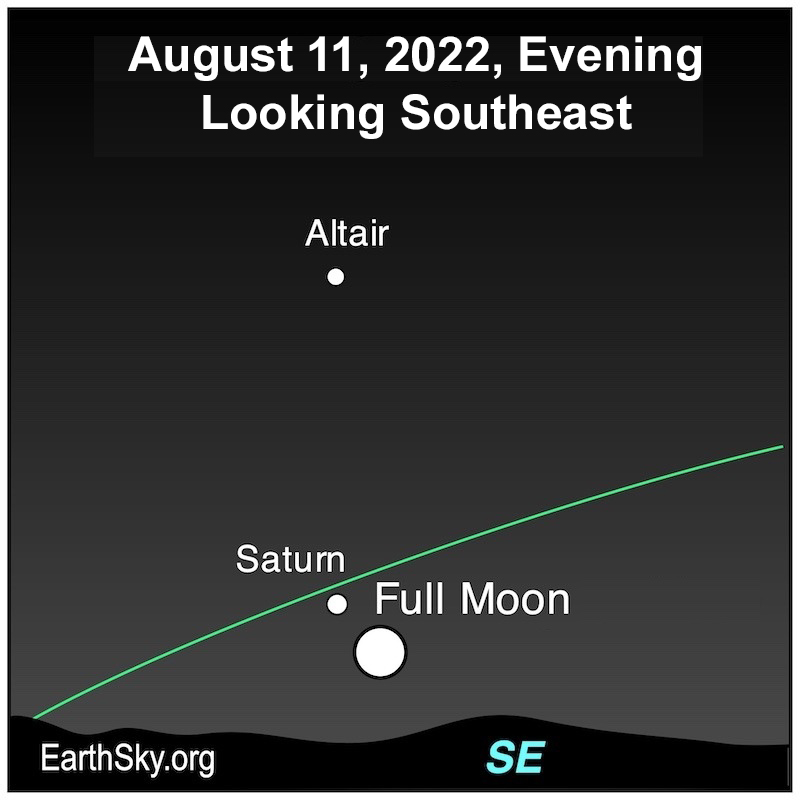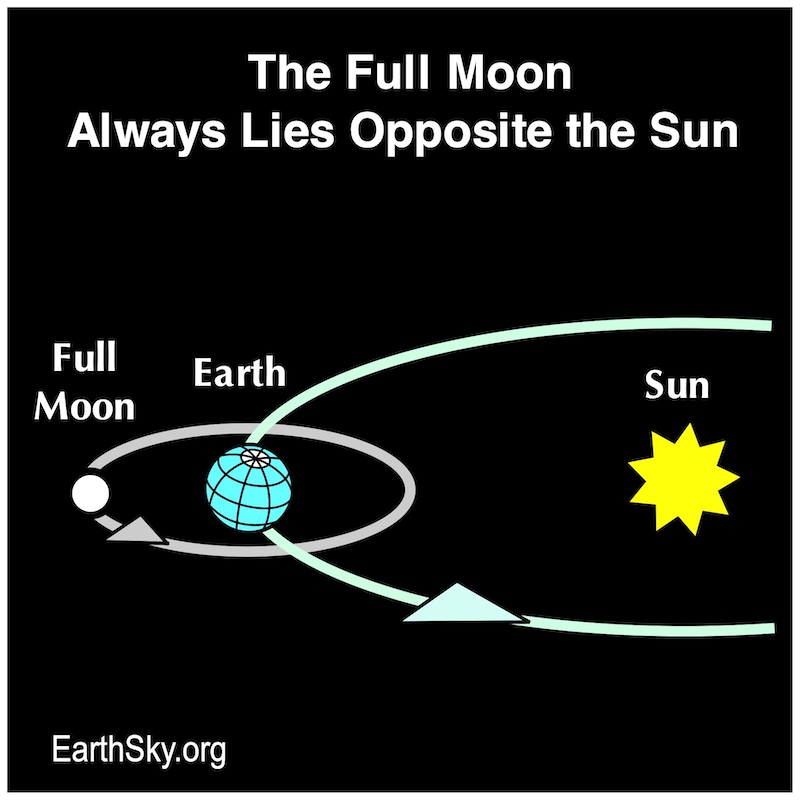
The full moon overnight on August 11-12 is the last full supermoon of 2022. As luck would have it, it falls at the peak of 2022’s Perseid meteor shower.
How to see the supermoon
Where and when to look in 2022: Look for the bright, round moon in the east at sunset on August 11. It’s highest in the sky around midnight. Conversely, it’s low in the west before sunrise.
Crest of the full moon falls at 1:36 UTC on August 12, 2022. That’s 8:36 p.m. CDT on August 11 in central North America. So, central North America sees its moonrise that evening, almost exactly as the moon reaches the crest of its full phase.
August 2022’s perigee falls about a day-and-a-half before the crest of this full moon. It falls at 17 UTC on August 10. Indeed, it’s close enough that Fred Espenak and others list this full moon on their supermoon tables. Also, a supermoon doesn’t look bigger to the eye alone. But it looks brighter. And sometimes particularly high tides will follow supermoons by a day or so.
Note: Supermoons are fun. But skywatchers will be shaking their fists at this one, because it falls smack in the middle of the peak mornings for the Perseid meteor shower. Read more below, or click in for 6 tips for watching the Perseids in moonlight.
Rise in the east, set in the west
All full moons rise in the east close to the time of sunset, no matter where you are on Earth. And likewise, all full moons set in the west close to the time of sunrise. At full moon, the sun, Earth, and moon are aligned in space, with Earth in the middle. The moon, on the other hand, is opposite the sun, visible all night. And also, the moon’s day side – its fully lighted hemisphere – directly faces us. That is, therefore, why the moon appears full.
Meteors in moonlight: 6 tips for 2022’s Perseids
Saturn at opposition: Earth flies between sun and Saturn on August 14

All the full moons have names. Popular ones for the August full moon include the Corn Moon and Sturgeon Moon. The name Sturgeon Moon recognizes the August peak of the sturgeon fish catch in the waters of North America’s Great Lakes. In addition, we’ve also heard the name Flying Up Moon for the August full moon.
Read: Full moon names by month and by season
August full moon meets SaturnThe full Sturgeon Moon will light the sky around it, blotting out all but the brightest stars. This month, however, a point of light shines next to the full moon. Look carefully in the bright moonlight, and you’ll see it. The light, in this case, isn’t a star. In fact, it’s Saturn, 6th planet from the sun. Saturn is also opposite the sun, as seen from Earth, this month. In other words, Earth passes between Saturn and the sun. For this reason, astronomers call it an opposition of Saturn. It’ll happen on August 14, 2022.
Read more about Saturn at opposition
August full moon blots out the Perseids
The beloved annual Perseid meteor shower peaks this year on the mornings of August 11, 12 and 13. But this bright full moon will be up in the sky during the peak hours for watching meteors – between midnight and dawn – on all of those nights.
Here’s how to watch meteors in moonlight: Perseids in 2022
August full moon in CapricornusThe August full moon can lie in front of one of two constellations of the zodiac. The one most often is Capricornus, the Sea-goat, while the other is Aquarius, the Water carrier.
As seen from the Americas, the full moon on overnight on August 11-12, 2022 will be located in the direction of southeastern Capricornus.

Bottom line: The full Corn Moon or Sturgeon Moon happens overnight on August 11-12, 2022. It is, notably, the last full supermoon of 2022. This full moon lies near Saturn and interferes with the Perseid meteor shower.
Meteors in moonlight: 6 tips for 2022’s Perseids
Saturn at opposition: Earth flies between sun and Saturn on August 14
The post August full moon – a supermoon – on August 11-12 first appeared on EarthSky.
0 Commentaires